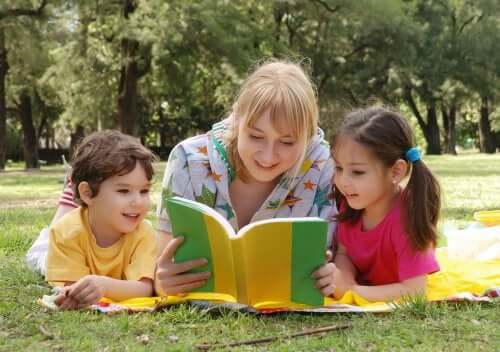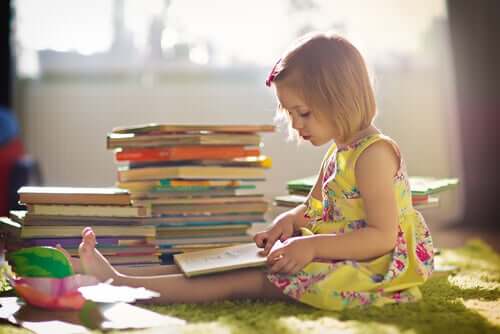3 Children's Books About Emotions

Although emotions play a critical role in a child’s life, it isn’t always easy for them to stay in control in many situations. In any case, you shouldn’t worry too much about this because, in this article, we’ve prepared a list of three children’s books about emotions.
Children’s responses to the different emotions they experience every day have a big impact on their choices, behavior, and how they deal with and enjoy life. Every child experiences feelings differently and learning to deal with their emotions is an important part of growing up.
Knowing how to describe emotions is important for children’s health and social-emotional development. As they grow and are exposed to different situations, their emotional lives become a lot more complicated.
Emotional learning begins at a fairly early age and emerges as children discover a wide range of emotions and evolve. Differences in children’s emotional competence can be observed from a very early age.
As children get older, family, peers, and teachers also play an important role in the development of emotional competence. However, the easiest way to help your children learn is by reading books about emotions and feelings to them.
For this reason, we’ve decided to prepare a list of some of the books that can help young children manage their emotions. Take note and discover our selection of children’s books about emotions!

3 children’s books about emotions
1. Glad Monster, Sad Monster by Ed Emberley
Glad Monster, Sad Monster is a book that can help children who lack the vocabulary to distinguish the emotions they feel. It can also help them find some comfort because it uses masks to identify different feelings. Each monster that appears in this book represents a different one.
Also, through the wide range of moods all the little monsters experience, children will learn to put themselves in their shoes and identify feelings and emotions. This is a fun, interactive way to explore different ways of expressing feelings and emotions!
2. The Grouchy Ladybug by Eric Carle
Now we present our second choice, where the author, Eric Carle, tells the story of a bad-tempered ladybug that can’t calm down and spends an entire day fighting with other creatures. The grouchy ladybug has bad manners, is very rude, and intimidates others.
This book is an excellent tool to teach children empathy, appropriate social skills, and how to treat others with respect. This book also offers the opportunity to teach children about time and the concept of size.
In addition, it also addresses a key point: the consequences of grouchiness and how hard it is to overcome this mood. Thus, it also allows you to talk to your child about emotions. Morality preaches understanding and exchange rather than the use of force and violence.
3. The Giving Tree by Shel Silverstein
Thirdly, this book tells the story of a boy and his best friend, which happens to be a tree. Every day, the child climbs the tree, eats apples, and sleeps in its shade. The story focuses on the feelings and conversations between the two.
The tree feels happy when the child plays with it and feels sad when the child leaves; it longs for his return and is willing to help the child with whatever he needs, even sacrificing itself in the process.

But as time goes on, the child visits the tree less and less, which makes the tree feel lonely. One day, the child returns and tells the tree he no longer wants to play with it like he used to because he’s too old to play and wants money now. The tree offers its apples to the child so that he can sell them to earn money. Finally, the child picks the apples and leaves.
The child does this two more times. After a long time, the child returns for a final visit. Although both the tree and the child are older, the latter finds a small space where he can sit to continue enjoying the tree’s company.
Before concluding, we should remind you that developing skills that allow children to control their emotions is very important for their emotional well-being. So what are you waiting for to read these books about emotions to your children? We’re sure they’ll love them!
Although emotions play a critical role in a child’s life, it isn’t always easy for them to stay in control in many situations. In any case, you shouldn’t worry too much about this because, in this article, we’ve prepared a list of three children’s books about emotions.
Children’s responses to the different emotions they experience every day have a big impact on their choices, behavior, and how they deal with and enjoy life. Every child experiences feelings differently and learning to deal with their emotions is an important part of growing up.
Knowing how to describe emotions is important for children’s health and social-emotional development. As they grow and are exposed to different situations, their emotional lives become a lot more complicated.
Emotional learning begins at a fairly early age and emerges as children discover a wide range of emotions and evolve. Differences in children’s emotional competence can be observed from a very early age.
As children get older, family, peers, and teachers also play an important role in the development of emotional competence. However, the easiest way to help your children learn is by reading books about emotions and feelings to them.
For this reason, we’ve decided to prepare a list of some of the books that can help young children manage their emotions. Take note and discover our selection of children’s books about emotions!

3 children’s books about emotions
1. Glad Monster, Sad Monster by Ed Emberley
Glad Monster, Sad Monster is a book that can help children who lack the vocabulary to distinguish the emotions they feel. It can also help them find some comfort because it uses masks to identify different feelings. Each monster that appears in this book represents a different one.
Also, through the wide range of moods all the little monsters experience, children will learn to put themselves in their shoes and identify feelings and emotions. This is a fun, interactive way to explore different ways of expressing feelings and emotions!
2. The Grouchy Ladybug by Eric Carle
Now we present our second choice, where the author, Eric Carle, tells the story of a bad-tempered ladybug that can’t calm down and spends an entire day fighting with other creatures. The grouchy ladybug has bad manners, is very rude, and intimidates others.
This book is an excellent tool to teach children empathy, appropriate social skills, and how to treat others with respect. This book also offers the opportunity to teach children about time and the concept of size.
In addition, it also addresses a key point: the consequences of grouchiness and how hard it is to overcome this mood. Thus, it also allows you to talk to your child about emotions. Morality preaches understanding and exchange rather than the use of force and violence.
3. The Giving Tree by Shel Silverstein
Thirdly, this book tells the story of a boy and his best friend, which happens to be a tree. Every day, the child climbs the tree, eats apples, and sleeps in its shade. The story focuses on the feelings and conversations between the two.
The tree feels happy when the child plays with it and feels sad when the child leaves; it longs for his return and is willing to help the child with whatever he needs, even sacrificing itself in the process.

But as time goes on, the child visits the tree less and less, which makes the tree feel lonely. One day, the child returns and tells the tree he no longer wants to play with it like he used to because he’s too old to play and wants money now. The tree offers its apples to the child so that he can sell them to earn money. Finally, the child picks the apples and leaves.
The child does this two more times. After a long time, the child returns for a final visit. Although both the tree and the child are older, the latter finds a small space where he can sit to continue enjoying the tree’s company.
Before concluding, we should remind you that developing skills that allow children to control their emotions is very important for their emotional well-being. So what are you waiting for to read these books about emotions to your children? We’re sure they’ll love them!
All cited sources were thoroughly reviewed by our team to ensure their quality, reliability, currency, and validity. The bibliography of this article was considered reliable and of academic or scientific accuracy.
- Bisquerra, R. (2011). Educación emocional. Propuestas para educadores y familias. Bilbao: Desclée de Brower. http://otrasvoceseneducacion.org/wp-content/uploads/2019/04/Educación-Emocional.-Propuestas-para-educadores-y-familias-Rafael-Bisquerra-Alzina-2.pdf
- Goleman, D. (2010). La práctica de la inteligencia emocional. Editorial Kairós.
- López, M. (2008). La integración de las habilidades sociales en la escuela como estrategia para la salud emocional. Psicología sin fronteras: revista electrónica de intervención psicosocial y psicología comunitaria, 3(1), 16-19.
- Shapiro, L. E. (2002). La salud emocional de los niños (Vol. 16). Edaf.
This text is provided for informational purposes only and does not replace consultation with a professional. If in doubt, consult your specialist.








